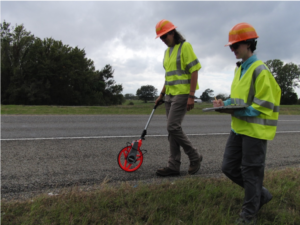Millions of monarch butterflies killed on Texas highways
Texas A&M works to protect monarchs on Texas roads, and they need your help
Monarch butterflies are moving south through Texas on their annual autumn migration to overwintering sites in Central Mexico, but millions die in collisions with vehicles while flying low across Texas highways. Monarch numbers have declined about 82% over the last 23 years, and road mortality can significantly contribute to their dwindling numbers.

The monarch butterfly, Texas’ state insect, was petitioned for protection under the federal Endangered Species Act in 2014. In response, many individuals, agencies and organizations, including Texas A&M’s Department of Entomology, have been working to understand why the monarch population is so diminished and find solutions.
The problem for monarch butterflies in Texas
The early spring and closing autumn monarch migratory events occur in Texas. Some monarchs travel 3,000 miles from Canada to Mexico in the autumn, then return another 1,000 miles back to Texas and Oklahoma in the spring to lay eggs. This gives the monarch the distinction of the longest migration of any insect.
On their journey North in the spring, monarchs lay eggs on milkweeds and pass through two generations in Texas before dispersing throughout the Midwest and Eastern U.S. Later generations reach as far north as Canada by the end of summer. On the return journey south during the autumn, the butterflies move through narrowing areas on their migration to Mexico. They basically go through a geographic funnel during their return to Mexico in the fall.
In previous investigations, Texas A&M researchers first uncovered a large amount of autumn monarch roadkill in West Texas, such as along Interstate Highway 10 from Junction to Sheffield. They found that road mortality of autumn-migrating monarchs from Oklahoma to Mexico depleted about 2-4% of the population that would typically arrive at Mexican overwintering sites.
“The mortality was observed to be clustered in “roadkill hotspots” in both the Central and Coastal flyways,” said James Tracy, Ph.D., a research associate for AgriLife Research working on the project. “Roadkill hotspots” are locations where monarch road death is highest.

A partnership to find a solution for monarch butterflies on Texas highways
The Texas Department of Transportation, TxDOT, Research and Technology Implementation Division is sponsoring research at the Texas A&M Transportation Institute, and the Knowledge Engineering Laboratory in the Department of Entomology, Texas A&M College of Agriculture and Life Sciences to systematically determine the location and extent of monarch roadkill on Texas roadways and consider mitigation strategies that could be implemented to reduce mortality.
“Over the next two years we are conducting four seasonal surveys of Texas roadways to identify the location and extent of roadkill hotspots,” said Robert Coulson, Ph.D., professor in the Department of Entomology.
The first of four Texas monarch roadkill field survey trips for this autumn was initiated in October and will continue through November. Surveys are conducted by field assistants Janice Bovankovich and Kaitlin Lopez, both experienced from previous fieldwork with Monarch Joint Venture.
Their task will be to survey dozens of 100-meter transects for road-killed monarchs along expansive stretches of Texas roadways. The surveys will be timed to follow the passage of monarchs on their southward migration. As the migration corridor narrows when approaching Mexico, populations of monarchs become more concentrated and road mortality is expected to increase.
Data from the surveys will be used to assess the impact of roadkill on the overwintering population in Mexico, to define the location and extent of roadkill hotspots, and to provide TxDOT mitigation options that could be implemented to reduce mortality.
Help identify monarch roadkill hotspots
The autumn migration is happening right now, and generally runs from October through mid-November, occurring latest along the Gulf Coast.
“If signs of these monarch roadkill hotspots are near you, please send us an email so we can come take a look,” Coulson said. “We need to know the timing and location of roadkill hotspots as the migration moves through Texas.”
Email Robert Coulson, r-coulson@tamu.edu, if you find a monarch roadkill hotspot near you.





